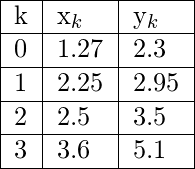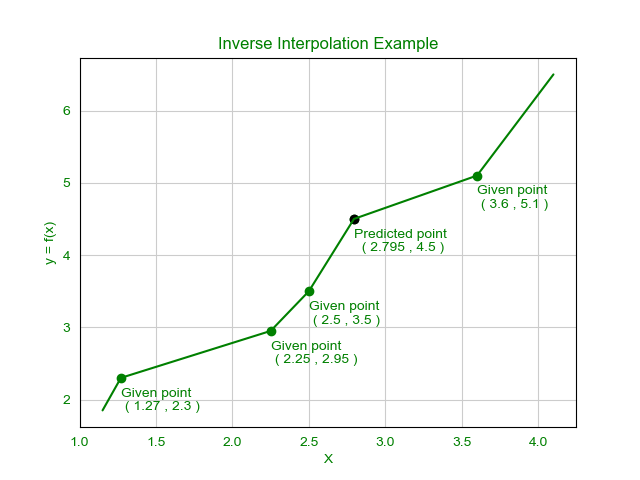给定任务是找到未知函数y = f(x)的给定y的x值,其中给出了一些点(x,y)对的值。
令y = f(x)是一个未知函数,其中x是一个独立变量。
对于x的不同值,说![]()
![]() 各自的值
各自的值![]()
![]() 给定的。
给定的。
借助给定的未知函数观测值,找到位于两个列表值之间的y的给定值的独立变量x的过程,称为逆插值。
这通常用于检查未知函数f的输出y的正确性,即该输出y的自变量x与原始输入有多少不同。
逆插值问题可以使用拉格朗日公式解决。
拉格朗日公式:
逆插值的公式与插值公式相似,但变化很小。
为了解决逆插值的问题,将x和y的位置互换。逆插值的公式为:

当点之间的间距不相等时,甚至可以使用此方法。在此,x表示为y的函数。
例子:
Input: Find the value of x where y = 4.5 and the given points are:

Output: 2.79501
Explanation: Here num of data points given = 4 and y = 4.5
So, putting the values of all x and y in the inverse interpolation formula given above we get,
From here we get,
The value of x = 2.79501 where the value of y = 4.5
图形: 
算法:
此处,数据是由x和y组成的点的列表,而n是数据点的数量。
STEP – 1 : Initialize the final value x = 0
STEP – 2 : FOR i = 1 to n do
STEP – 3 : Initialize xi = data[i].x
STEP – 4 : FOR j = 1 to n do
STEP – 5 : IF i != j do
STEP – 6 : Multiply xi by ( y – data[j].y ) and divide by ( data[i].y – data[j].y )
ENDIF
ENDFOR
STEP – 7 : Add xi to x
ENDFOR
STEP – 8 : Return final value of x
STEP – 9 : END
执行:
C++
// C++ code for solving inverse interpolation
#include
using namespace std;
// Consider a structure
// to keep each pair of
// x and y together
struct Data {
double x, y;
};
// Function to calculate
// the inverse interpolation
double inv_interpolate(Data d[], int n, double y)
{
// Initialize final x
double x = 0;
int i, j;
for (i = 0; i < n; i++) {
// Calculate each term
// of the given formula
double xi = d[i].x;
for (j = 0; j < n; j++) {
if (j != i) {
xi = xi
* (y - d[j].y)
/ (d[i].y - d[j].y);
}
}
// Add term to final result
x += xi;
}
return x;
}
// Driver Code
int main()
{
// Sample dataset of 4 points
// Here we find the value
// of x when y = 4.5
Data d[] = { { 1.27, 2.3 },
{ 2.25, 2.95 },
{ 2.5, 3.5 },
{ 3.6, 5.1 } };
// Size of dataset
int n = 4;
// Sample y value
double y = 4.5;
// Using the Inverse Interpolation
// function to find the
// value of x when y = 4.5
cout << "Value of x at y = 4.5 : "
<< inv_interpolate(d, n, y);
return 0;
} Java
// Java code for solving inverse interpolation
class GFG
{
// Consider a structure
// to keep each pair of
// x and y together
static class Data
{
double x, y;
public Data(double x, double y)
{
super();
this.x = x;
this.y = y;
}
};
// Function to calculate
// the inverse interpolation
static double inv_interpolate(Data []d, int n, double y)
{
// Initialize final x
double x = 0;
int i, j;
for (i = 0; i < n; i++)
{
// Calculate each term
// of the given formula
double xi = d[i].x;
for (j = 0; j < n; j++)
{
if (j != i)
{
xi = xi
* (y - d[j].y)
/ (d[i].y - d[j].y);
}
}
// Add term to final result
x += xi;
}
return x;
}
// Driver Code
public static void main(String[] args)
{
// Sample dataset of 4 points
// Here we find the value
// of x when y = 4.5
Data []d = { new Data( 1.27, 2.3 ),
new Data( 2.25, 2.95 ),
new Data( 2.5, 3.5 ),
new Data( 3.6, 5.1 ) };
// Size of dataset
int n = 4;
// Sample y value
double y = 4.5;
// Using the Inverse Interpolation
// function to find the
// value of x when y = 4.5
System.out.printf("Value of x at y = 4.5 : %.5f"
, inv_interpolate(d, n, y));
}
}
// This code is contributed by Rajput-JiPython3
# Python3 code for solving
# inverse interpolation
# Consider a structure
# to keep each pair of
# x and y together
class Data:
def __init__(self, x, y):
self.x = x
self.y = y
# Function to calculate
# the inverse interpolation
def inv_interpolate(d: list, n: int,
y: float) -> float:
# Initialize final x
x = 0
for i in range(n):
# Calculate each term
# of the given formula
xi = d[i].x
for j in range(n):
if j != i:
xi = (xi * (y - d[j].y) /
(d[i].y - d[j].y))
# Add term to final result
x += xi
return x
# Driver Code
if __name__ == "__main__":
# Sample dataset of 4 points
# Here we find the value
# of x when y = 4.5
d = [Data(1.27, 2.3),
Data(2.25, 2.95),
Data(2.5, 3.5),
Data(3.6, 5.1)]
# Size of dataset
n = 4
# Sample y value
y = 4.5
# Using the Inverse Interpolation
# function to find the
# value of x when y = 4.5
print("Value of x at y = 4.5 :",
round(inv_interpolate(d, n, y), 5))
# This code is contributed by
# sanjeev2552C#
// C# code for solving inverse interpolation
using System;
class GFG
{
// Consider a structure to keep
// each pair of x and y together
class Data
{
public double x, y;
public Data(double x, double y)
{
this.x = x;
this.y = y;
}
};
// Function to calculate the
// inverse interpolation
static double inv_interpolate(Data []d,
int n, double y)
{
// Initialize readonly x
double x = 0;
int i, j;
for (i = 0; i < n; i++)
{
// Calculate each term
// of the given formula
double xi = d[i].x;
for (j = 0; j < n; j++)
{
if (j != i)
{
xi = xi * (y - d[j].y) /
(d[i].y - d[j].y);
}
}
// Add term to readonly result
x += xi;
}
return x;
}
// Driver Code
public static void Main(String[] args)
{
// Sample dataset of 4 points
// Here we find the value
// of x when y = 4.5
Data []d = {new Data(1.27, 2.3),
new Data(2.25, 2.95),
new Data(2.5, 3.5),
new Data(3.6, 5.1)};
// Size of dataset
int n = 4;
// Sample y value
double y = 4.5;
// Using the Inverse Interpolation
// function to find the
// value of x when y = 4.5
Console.Write("Value of x at y = 4.5 : {0:f5}",
inv_interpolate(d, n, y));
}
}
// This code is contributed by Rajput-JiValue of x at y = 4.5 : 2.79501
复杂度:给定解的时间复杂度为O(n ^ 2) ,空间复杂度为O(1)